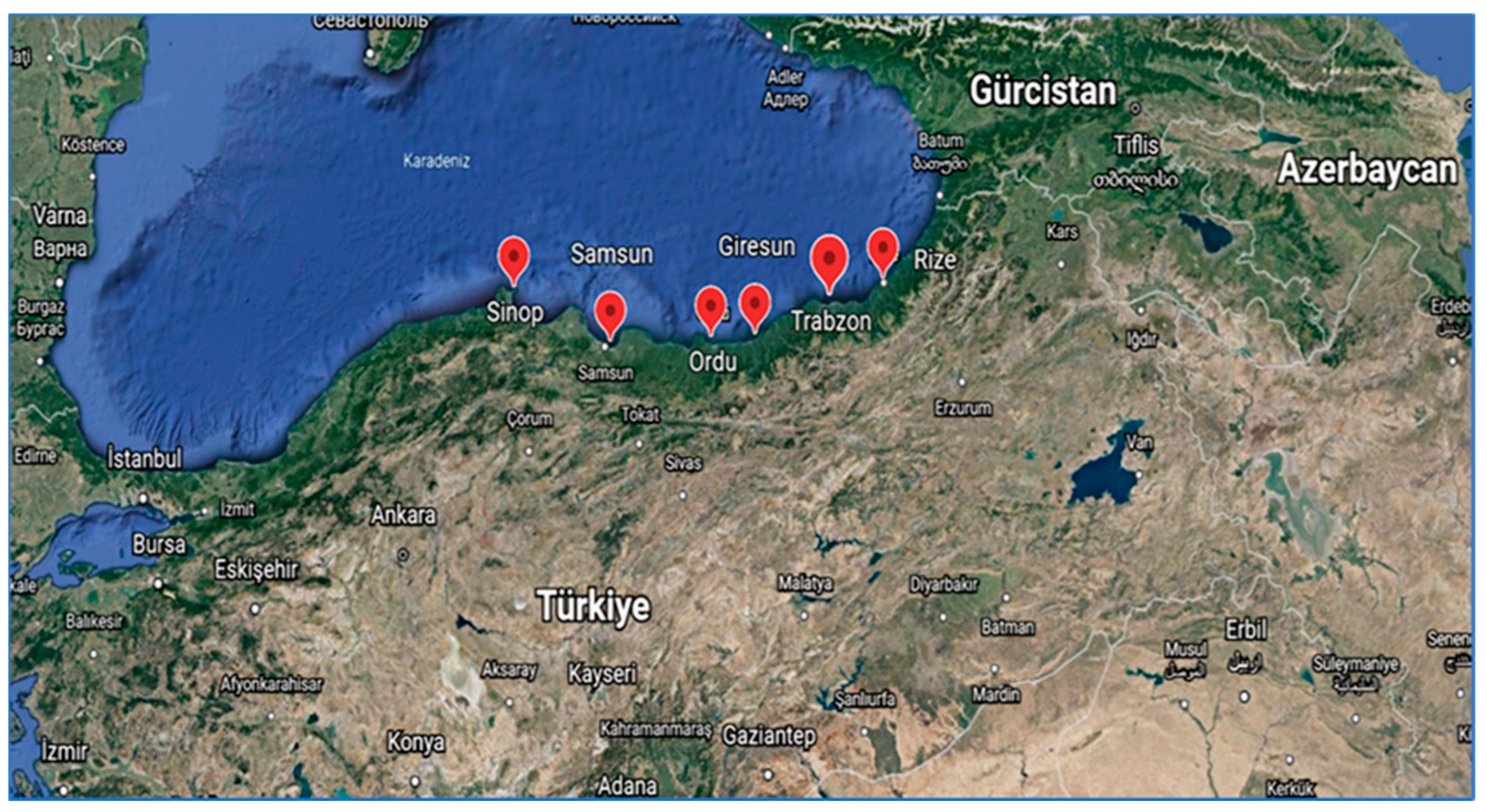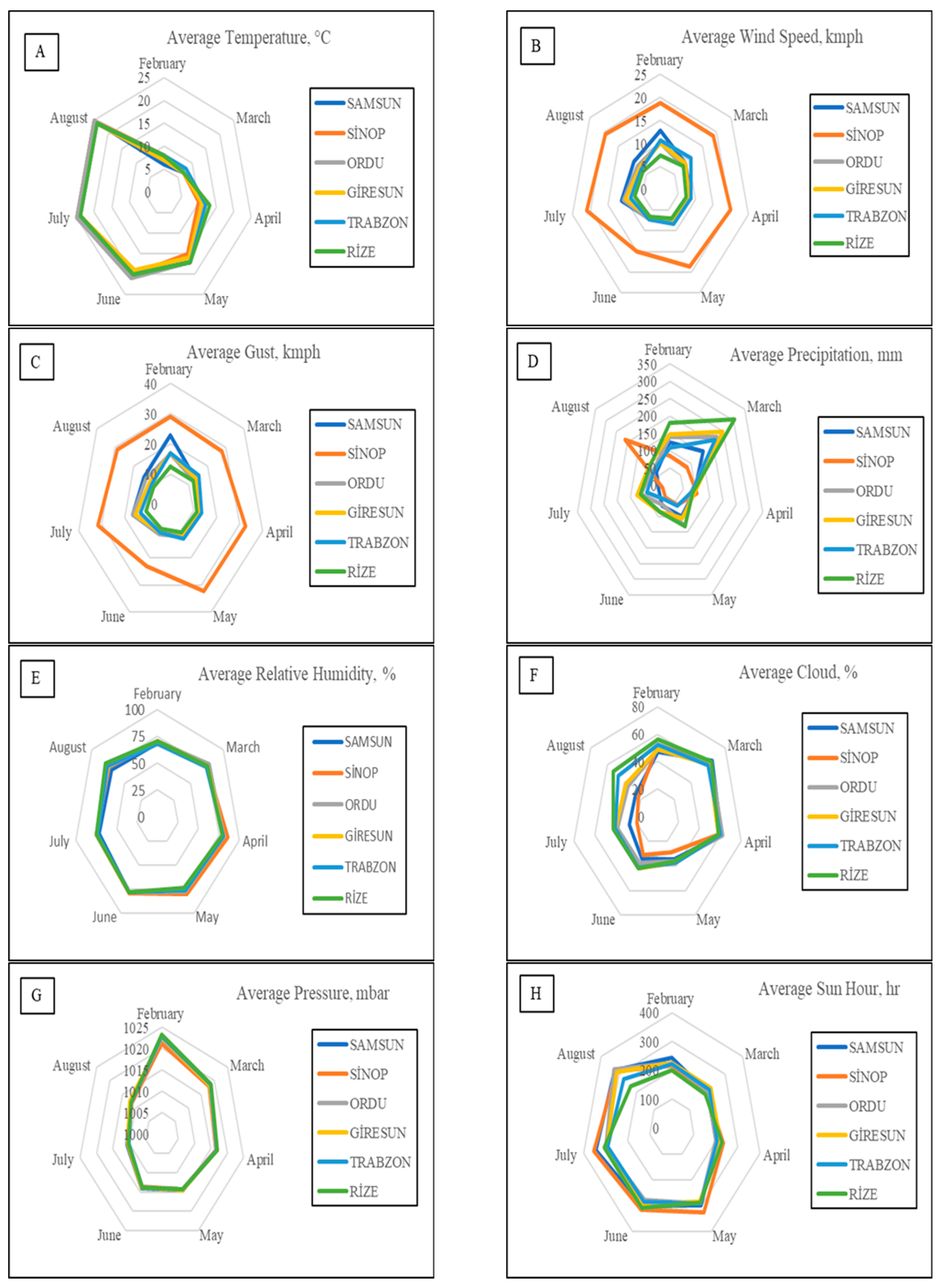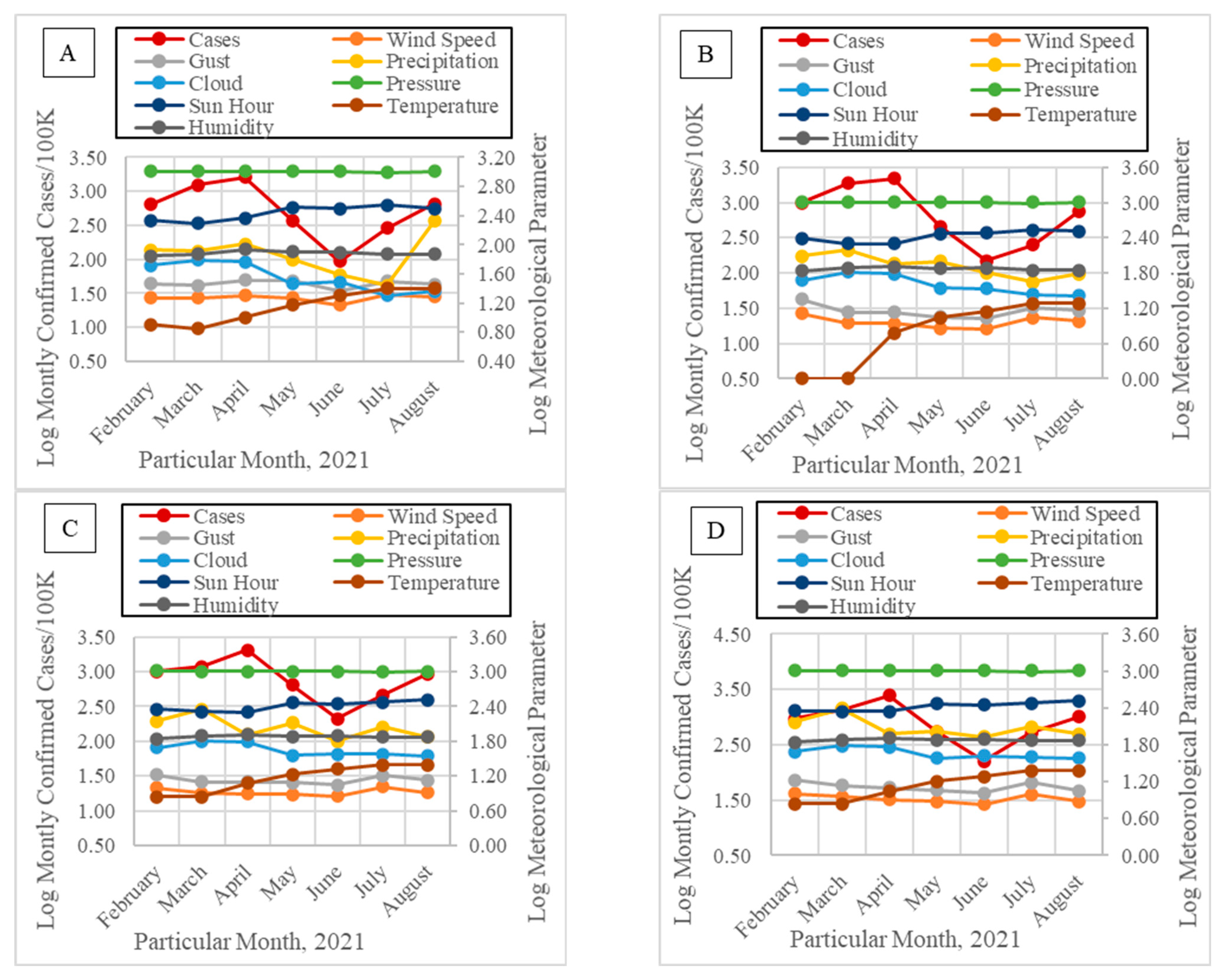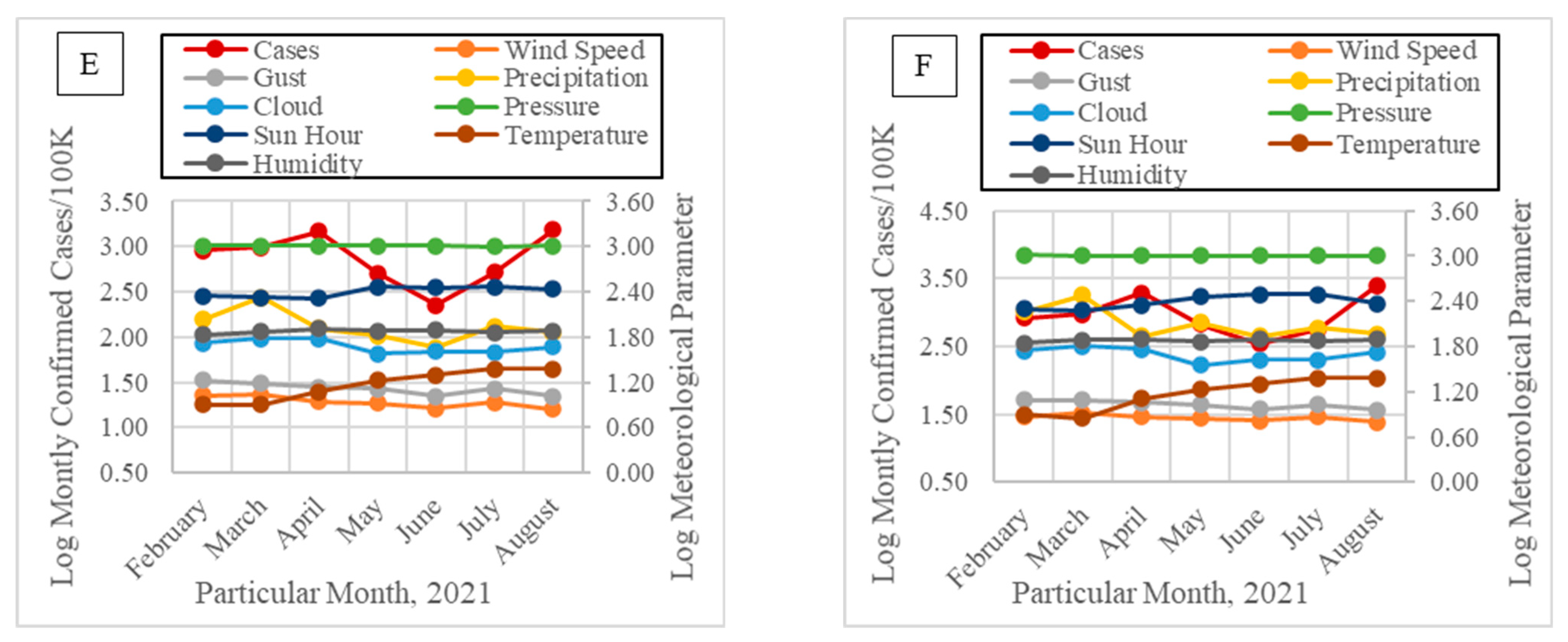Transmission of COVID-19 in Cities with Weather Conditions of High Air Humidity: Lessons Learned from Turkish Black Sea Region to Face Next Pandemic Crisis
Abstract
:1. Introduction
| Study Period | Study Region (Country) | Indicators | Statistical Analyses | Results/Suggestions | References |
|---|---|---|---|---|---|
| 3 February to 14 July 2020 | Spain | Solar radiation, precipitation, daily temperature, and wind speed | Multilevel Poisson regression | Air pollution can be a key factor in understanding the mortality rate for COVID-19 in Spain. | [32] |
| 1 July to 31 October 2020 | Brazil | Atmospheric pressure, temperature, relative humidity, wind speed, solar irradiation, sunlight, dew point temperature, and total precipitation | Pearson’s correlation and regression tree analysis | The results present meteorological information as critical in future risk assessment models. | [33] |
| 9 March to 19 November 2020 | Saudi Arabia | Wind speed and temperature | Poisson regression | Air pollution could be a significant risk factor for respiratory infections and virus transmission. | [34] |
| February to 10 April 2020 | Canada | Temperature and humidity | The quantile-on-quantile (QQR) approach | Temperature and humidity have a direct negative relationship with COVID-19 infections. | [35] |
| April to May 2020 | Bangladesh | Rainfall, temperature, relative humidity, and wind speed | Spearman’s rank correlation | Significant positive associations were found between relative humidity and COVID-19 cases, while with temperature, both positive and negative associations with | [36] |
| February to June 2020 | India | Temperature, relative humidity, and wind speed | Pearson correlation | meteorological parameters may have promoted COVID-19 incidences, especially confirmed cases. | [37] |
| 3 February to 5 May 2020 | Korea | Temperature, wind speed, humidity, and air pressure | Generalized additive model | There was a significant nonlinear relationship between daily temperature and humidity and COVID-19 confirmed cases. | [38] |
| 1 March to 7 July 2020 | The U.S. | Temperature and humidity | Pearson, Spearman, and Kendall’s rank correlations | The temperature was found to have a negative correlation, while humidity highlighted a positive correlation with daily new cases of COVID-19 in New Jersey. | [39] |
| As of 27 March 2020 | 166 countries excluding China | Temperature and humidity | A log-linear generalized additive model | The COVID-19 pandemic may be partially suppressed by temperature and humidity increases. | [40] |
| Third week of March 2020 | 21 countries and the French administrative regions | Temperature | ARIMA model | High temperatures diminish initial contagion rates, but the effects of seasonal temperature at later stages of the epidemy remain questionable. | [41] |
| Up to 10 February 2020 for China and from 15 March to 25 April 2020 for the U.S. | China and the U.S. | Temperature and humidity | Regression Analysis | Higher temperature and higher relative humidity in summer may potentially reduce the transmission of COVID-19. | [42] |
2. Materials and Methods
- Can the transmission of COVID-19 and other similar airborne diseases be explained by specific meteorological factors produced by high air humidity?
2.1. Sample and Data
2.2. Measurements of Variables
- COVID-19 confirmed cases: Number of infected individuals from 8 February to 3 May 2021, based on the amount of people that tested positive for COVID-19 using Antigen tests.
- Meteorological indicators: Average temperature in °C, average wind speed in kmph, average gust in kmph, average precipitation in mm, average relative humidity%, average cloud%, average atmospheric pressure in mbar, and average hours of sunshine from 8 February to 3 September 2021.
2.3. Data Analysis Procedure
3. Results of Empirical Evidence
3.1. Overview of the Climate in Cities of the Turkish Black Sea Region
3.2. Relations between COVID-19 Confirmed Cases and Meteorological Factors in the Cities of Turkish Black Sea Region
4. Discussion
5. Conclusions, Limitations and Prospects
Supplementary Materials
Author Contributions
Funding
Institutional Review Board Statement
Informed Consent Statement
Data Availability Statement
Acknowledgments
Conflicts of Interest
References
- Akan, A.P.; Coccia, M. Changes of Air Pollution between Countries Because of Lockdowns to Face COVID-19 Pandemic. Appl. Sci. 2022, 12, 12806. [Google Scholar] [CrossRef]
- Bontempi, E.; Coccia, M. International trade as critical parameter of COVID-19 spread that outclasses demographic, economic, environmental, and pollution factors. Environ. Res. 2021, 201, 111514. [Google Scholar] [CrossRef] [PubMed]
- Bontempi, E.; Coccia, M.; Vergalli, S.; Zanoletti, A. Can commercial trade represent the main indicator of the COVID-19 diffusion due to human-to-human interactions? A comparative analysis between Italy, France, and Spain. Environ. Res. 2021, 201, 111529. [Google Scholar] [CrossRef]
- Coccia, M. Recurring waves of COVID-19 pandemic with different effects in public health. J. Econ. Bib. 2021, 8, 28–45. [Google Scholar] [CrossRef]
- Coccia, M. Pandemic Prevention: Lessons from COVID-19. Encyclopedia 2021, 1, 433–444. [Google Scholar] [CrossRef]
- Coccia, M. Optimal levels of vaccination to reduce COVID-19 infected individuals and deaths: A global analysis. Environ. Res. 2022, 204, 112314. [Google Scholar] [CrossRef]
- Coccia, M. The Spread of the Novel Coronavirus Disease-2019 in Polluted Cities: Environmental and Demographic Factors to Control for the Prevention of Future Pandemic Diseases. In Socioeconomic Dynamics of the COVID-19 Crisis; Faghih, N., Forouharfar, A., Eds.; Springer: Cham, Switzerland, 2022; pp. 351–369. [Google Scholar] [CrossRef]
- Coccia, M. Effects of strict containment policies on COVID-19 pandemic crisis: Lessons to cope with next pandemic impacts. Environ. Sci. Pollut. Res. Int. 2023, 30, 2020–2028. [Google Scholar] [CrossRef]
- World Health Organization. WHO Data. 2021. Available online: https://covid19.who.int/ (accessed on 27 September 2021).
- Coccia, M. Effects of Air Pollution on COVID-19 and Public Health, Research Article-Environmental Economics-Environmental Policy, ResearchSquare. 2020. Available online: https://www.researchsquare.com/article/rs-41354/v1 (accessed on 27 September 2023).
- Coccia, M. High potential of technology to face new respiratory viruses: Mechanical ventilation devices for effective healthcare to next pandemic emergencies. Technol. Soc. 2023, 73, 102233. [Google Scholar] [CrossRef]
- Akan, A.P. Transmission of COVID-19 pandemic (Turkey) associated with short-term exposure of air quality and climatological parameters. Environ. Sci. Pollut. Res. 2022, 29, 41695–41712. [Google Scholar] [CrossRef]
- Domingo, J.L.; Marquès, M.; Rovira, J. Influence of airborne transmission of SARS-CoV-2 on COVID-19 pandemic. A review. Environ. Res. 2020, 188, 109861. [Google Scholar] [CrossRef]
- Núñez-Delgado, A.; Bontempi, E.; Coccia, M.; Kumar, M.; Farkas, K.; Domingo, J.L. SARS-CoV-2 and other pathogenic microorganisms in the environment. Environ. Res. 2021, 201, 111606. [Google Scholar] [CrossRef] [PubMed]
- Rahimi, N.R.; Fouladi-Fard, R.; Aali, R.; Shahryari, A.; Rezaali, M.; Ghafouri, Y.; Ghalhari, M.R.; Asadi-Ghalhari, M.; Farzinnia, B.; Gea, O.C.; et al. Bidirectional association between COVID-19 and the environment: A systematic review. Environ. Res. 2021, 194, 110692. [Google Scholar] [CrossRef] [PubMed]
- Bashir, M.F.; Ma, B.; Bilal Komal, B.; Bashir, M.A.; Tan, D.; Bashir, M. Correlation between climate indicators and COVID-19 pandemic in New York, USA. Sci. Total Environ. 2020, 728, 138835. [Google Scholar] [CrossRef]
- Bolaño-Ortiz, T.R.; Camargo-Caicedo, Y.; Puliafito, S.E.; Ruggeri, M.F.; Bolaño-Diaz, S.; Pascual-Flores, R.; Saturno, J.; Ibarra-Espinosa, S.; Mayol-Bracero, O.L.; Torres-Delgado, E.; et al. Spread of SARS-CoV-2 through Latin America and the Caribbean region: A look from its economic conditions, climate and the air pollution indicators. Environ. Res. 2020, 191, 109938. [Google Scholar] [CrossRef] [PubMed]
- Iha, Y.; Kinjo, T.; Parrott, G.; Higa, F.; Mori, H.; Fujita, J. Comparative epidemiology of influenza A and B viral infection in a subtropical region: A 7-year surveillance in Okinawa, Japan. BMC Infect. Dis. 2016, 16, 650. [Google Scholar] [CrossRef] [PubMed]
- Lin, Y.; Chang, C.; Chang, S.; Chen, P.; Lin, C.; Wang, Y. Temperature, nitrogen dioxide, circulating respiratory viruses and acute upper respiratory infections among children in Taipei, Taiwan: A population-based study. Environ. Res. 2013, 120, 109–118. [Google Scholar] [CrossRef]
- Şahin, M. Impact of weather on COVID-19 pandemic in Turkey. Sci. Total Environ. 2020, 728, 138810. [Google Scholar] [CrossRef]
- Tosepu, R.; Gunawan, J.; Effendy, D.S.; Ahmad, L.O.A.I.; Lestari, H.; Bahar, H.; Asfian, P. Correlation between weather and COVID-19 pandemic in Jakarta, Indonesia. Sci. Total Environ. 2020, 725, 138436. [Google Scholar] [CrossRef]
- Srivastava, A. COVID-19 and air pollution and meteorology-an intricate relationship: A review. Chemosphere 2021, 263, 128297. [Google Scholar] [CrossRef]
- Cai, Q.C.; Lu, J.; Xu, Q.F.; Guo, Q.; Xu, D.Z.; Sun, Q.W.; Yang, H.; Zhao, G.M.; Jiang, Q.W. Influence of meteorological factors and air pollution on the outbreak of severe acute respiratory syndrome. Public Health 2007, 121, 258–265. [Google Scholar] [CrossRef]
- Yuan, J.; Yun, H.; Lan, W.; Wang, W.; Sullivan, S.G.; Jia, S.; Bittles, A.H. A climatologic investigation of the SARS-CoV outbreak in Beijing, China. Am. J. Infect. Control 2006, 34, 234–236. [Google Scholar] [CrossRef] [PubMed]
- Guo, C.; Bo, Y.; Lin, C.; Li, H.B.; Zeng, Y.; Zhang, Y.; Hossain, S.; Chan, J.W.; Yeung, D.W.; Kwok, K.-O.; et al. Meteorological factors and COVID-19 incidence in 190 countries: An observational study. Sci. Total Environ. 2021, 757, 143783. [Google Scholar] [CrossRef] [PubMed]
- Islam, A.R.M.T.; Hasanuzzaman; Azad, A.K.; Salam, R.; Toshi, F.Z.; Khan, S.I.; Alam, G.M.M.; Ibrahim, S.M. Effect of meteorological factors on COVID-19 cases in Bangladesh. Environ. Dev. Sustain. 2021, 23, 9139–9162. [Google Scholar] [CrossRef]
- Coccia, M. An index to quantify environmental risk of exposure to future epidemics of the COVID-19 and similar viral agents: Theory and practice. Environ. Res. 2020, 191, 110155. [Google Scholar] [CrossRef] [PubMed]
- Coccia, M. The effects of atmospheric stability with low wind speed and of air pollution on the accelerated transmission dynamics of COVID-19. Int. J. Environ. Sci. 2021, 78, 1–27. [Google Scholar] [CrossRef]
- Coccia, M. How do low wind speeds and high levels of air pollution support the spread of COVID-19? Atmos. Pol. Res. 2021, 12, 437–445. [Google Scholar] [CrossRef]
- Coşkun, H.; Yıldırım, N.; Gündüz, S. The spread of COVID-19 virus through population density and wind in Turkey cities. Sci. Total Environ. 2021, 751, 141663. [Google Scholar] [CrossRef]
- Aral, N.; Bakır, H. Spatiotemporal Analysis of COVID-19 in Turkey. Sustain. Cities Soc. 2022, 76, 103421. [Google Scholar] [CrossRef]
- Sanchez-Piedra, C.; Cruz-Cruz, C.; Gamiño-Arroyo, A.E.; Prado-Galbarro, F.J. Effects of air pollution and climatology on COVID-19 mortality in Spain. Air Qual. Atmos. Health 2021, 14, 1869–1875. [Google Scholar] [CrossRef]
- Olak, A.S.; Santos, W.S.; Susuki, A.M.; Pott-Junior, H.; Skalny, A.V.; Tinkov, A.A.; Aschner, M.; Pinese, J.P.P.; Urbano, M.R.; Paoliello, M.M.B. Meteorological parameters and cases of COVID-19 in Brazilian cities: An observational study. J. Toxicol. Environ. Health A 2021, 85, 14–28. [Google Scholar] [CrossRef]
- Maatoug, A.B.; Triki, M.B.; Fazel, H. How do air pollution and meteorological parameters contribute to the spread of COVID-19 in Saudi Arabia? Environ. Sci. Pollut. Res. 2021, 28, 44132–44139. [Google Scholar] [CrossRef] [PubMed]
- Sarwar, S.; Shahzad, K.; Fareed, Z.; Shahzad, U. A study on the effects of meteorological and climatic factors on the COVID-19 spread in Canada during 2020. J. Environ. Health Sci. Eng. 2021, 19, 1513–1521. [Google Scholar] [CrossRef] [PubMed]
- Pal, S.K.; Masum, M.H. Effects of meteorological parameters on COVID-19 transmission trends in Bangladesh. Environ. Sustain. 2021, 4, 559–568. [Google Scholar] [CrossRef]
- Kolluru, S.S.R.; Patra, A.K.; Nazneen Nagendra, S.M.S. Association of air pollution and meteorological variables with COVID-19 incidence: Evidence from five megacities in India. Environ. Res. 2021, 195, 110854. [Google Scholar] [CrossRef]
- Hoang, T.; Tran, T.T.A. Ambient air pollution, meteorology, and COVID-19 infection in Korea. J. Med. Virol. 2021, 93, 878–885. [Google Scholar] [CrossRef]
- Doğan, B.; Jebli, M.B.; Shahzad KFarooq, T.H.; Shahzad, U. Investigating the Effects of Meteorological Parameters on COVID-19: Case Study of New Jersey, United States. Environ. Res. 2020, 191, 110148. [Google Scholar] [CrossRef]
- Wu, Y.; Jing, W.; Liu, J.; Ma, Q.; Yuan, J.; Wang, Y.; Du, M.; Liu, M. Effects of temperature and humidity on the daily new cases and new deaths of COVID-19 in 166 countries. Sci. Total Environ. 2020, 729, 139051. [Google Scholar] [CrossRef]
- Demongeot, J.; Flet-Berliac, Y.; Seligmann, H. Temperature decreases spread parameters of the new COVID-19 case dynamics. Biology 2020, 9, 94. [Google Scholar] [CrossRef]
- Wang, J.; Tang, K.; Feng, K.; Lv, W. High Temperature and High Humidity Reduce the Transmission of COVID-19. 2020. Available online: https://www.scienceopen.com/document_file/ff8b579c-26ff-4c3c-9aa5-a141bc8e35f6/PubMedCentral/ff8b579c-26ff-4c3c-9aa5-a141bc8e35f6.pdf (accessed on 27 September 2023).
- COVID-19. Information about COVID-19 Cases from the Republic of Turkey Ministry of Health. 2021. Available online: https://covid19.saglik.gov.tr/?_Dil=2 (accessed on 25 September 2022).
- World Weather Online. WWO Data. 2021. Available online: https://www.worldweatheronline.com (accessed on 27 January 2023).
- Haque, S.E.; Rahman, M. Association between temperature, humidity, and COVID-19 outbreaks in Bangladesh. Environ. Sci. Policy 2020, 114, 253–255. [Google Scholar] [CrossRef]
- Rosario, D.K.A.; Mutz, Y.S.; Bernardes, P.C.; Conte-Junior, C.A. Relationship between COVID-19 and weather: Case study in a tropical country. Int. J. Hydrog. Environ. Health 2020, 229, 113587. [Google Scholar] [CrossRef]
- Sarkodie, S.A.; Owusu, P.A. Impact of meteorological factors on COVID-19 pandemic: Evidence from top 20 countries with confirmed cases. Environ. Res. 2020, 191, 110101. [Google Scholar] [CrossRef] [PubMed]
- Coccia, M. COVID-19 pandemic over 2020 (with lockdowns) and 2021 (with vaccinations): Similar effects for seasonality and environmental factors. Environ. Res. 2022, 208, 112711. [Google Scholar] [CrossRef] [PubMed]
- Yao, Y.; Pan, J.; Wang, W.; Liu, Z.; Kan, H.; Qui, Y.; Meng, X.; Wang, W. Association of particular matter pollution and case fatality rate of COVID-19 in 49 Chinese cities. Sci. Total Environ. 2020, 741, 140396. [Google Scholar] [CrossRef]
- Xie, J.; Zhu, Y. Association between ambient temperature and COVID-19 infection in122 cities from China. Sci. Total Environ. 2020, 724, 138201. [Google Scholar] [CrossRef]
- Zoran, M.A.; Savastru, R.S.; Savastru, D.M.; Tautan, M.N. Assessing the relationship between surface levels of PM2.5and PM10 particulate matter impact on COVID-19 in Milan, Italy. Sci. Total Environ. 2020, 738, 139825. [Google Scholar] [CrossRef]
- Schuit, M.; Ratnesar-Shumate, S.; Yolitz, J.; Williams, G.; Weaver, W.; Green, B.; Miller, D.; Krause, M.; Beck, K.; Wood, S.; et al. Airborne SARS-CoV-2 is rapidly inactivated by simulated sunlight. J. Infect. Dis. 2020, 222, 564–571. [Google Scholar] [CrossRef]
- Coccia, M. Effects of the spread of COVID-19 on public health of polluted cities: Results of the first wave for explaining the dejà vu in the second wave of COVID-19 pandemic and epidemics of future vital agents. Environ. Sci. Pollut. Res. 2021, 28, 19147–19154. [Google Scholar] [CrossRef]
- COP26. 26th Conference of Parties, United Nations Framework Convention on Climate Change. 2021. Available online: https://unfccc.int/conference/glasgow-climate-change-conference-october-november-2021 (accessed on 29 December 2021).
- Caliskan, B.; Özengin, N.; Cindoruk, S.S. Air quality level, emission sources and control strategies in Bursa/Turkey. Atmos. Pollut. Res. 2020, 11, 2182–2189. [Google Scholar] [CrossRef]
- Coccia, M. Comparative Critical Decisions in Management. In Global Encyclopedia of Public Administration, Public Policy, and Governance; Farazmand, A., Ed.; Springer Nature: Cham, Switzerland, 2021. [Google Scholar] [CrossRef]
- Coccia, M. The relation between length of lockdown, numbers of infected people and deaths of COVID-19, and economic growth of countries: Lessons learned to cope with future pandemics similar to COVID-19 and to constrain the deterioration of economic system. Sci. Total Environ. 2021, 775, 145801. [Google Scholar] [CrossRef]
- Aykaç, N.; Etiler, N. COVID-19 mortality in Istanbul in association with air pollution and socioeconomic status: An ecological study. Environ. Sci. Pollut. Res. 2021, 29, 13700–13708. [Google Scholar] [CrossRef]
- Benati, I.; Coccia, M. Global analysis of timely COVID-19 vaccinations: Improving governance to reinforce response policies for pandemic crises. Int. J. Health Gov. 2022, 27, 240–253. [Google Scholar] [CrossRef]
- Benati, I.; Coccia, M. Effective Contact Tracing System Minimizes COVID-19 Related Infections and Deaths: Policy Lessons to Reduce the Impact of Future Pandemic Diseases. J. Public Adm. Gov. 2022, 12, 19–33. [Google Scholar] [CrossRef]
- Coccia, M.; Benati, I. Comparative Evaluation Systems. In Global Encyclopedia of Public Administration, Public Policy, and Governance; Farazmand, A., Ed.; Springer Nature: Cham, Switzerland, 2018. [Google Scholar] [CrossRef]
- Coccia, M. Preparedness of countries to face COVID-19 pandemic crisis: Strategic positioning and factors supporting effective strategies of prevention of pandemic threats. Environ. Res. 2022, 203, 111678. [Google Scholar] [CrossRef]
- Coccia, M. Sources, diffusion and prediction in COVID-19 pandemic: Lessons learned to face next health emergency. AIMS Public Health 2023, 10, 145–168. [Google Scholar] [CrossRef]
- Coccia, M. Factors determining the diffusion of COVID-19 and suggested strategy to prevent future accelerated viral infectivity similar to COVID. Sci. Total Environ. 2020, 729, 138474. [Google Scholar] [CrossRef]
- Coccia, M. Comparative Institutional Changes. In Global Encyclopedia of Public Administration, Public Policy, and Governance; Farazmand, A., Ed.; Springer Nature: Cham, Switzerland, 2019. [Google Scholar] [CrossRef]
- Coccia, M. Intrinsic and extrinsic incentives to support motivation and performance of public organizations. J. Econ. Bibliogr. 2019, 6, 20–29. [Google Scholar] [CrossRef]
- Coccia, M. General properties of the evolution of research fields: A scientometric study of human microbiome, evolutionary robotics and astrobiology. Scientometrics 2018, 117, 1265–1283. [Google Scholar] [CrossRef]
- Coccia, M. Asymmetry of the technological cycle of disruptive innovations. Technol. Anal. Strateg. Manag. 2020, 32, 1462–1477. [Google Scholar] [CrossRef]
- Coccia, M. New directions of technologies pointing the way to a sustainable global society. Sustain. Futures 2023, 5, 100114. [Google Scholar] [CrossRef]
- Magazzino, C.; Mele, M.; Coccia, M. A machine learning algorithm to analyze the effects of vaccination on COVID-19 mortality. Epidemiol. Infect. 2022, 150, e168. [Google Scholar] [CrossRef]
- Coccia, M. A new approach for measuring and analyzing patterns of regional economic growth: Empirical analysis in Italy. Ital. J. Reg. Sci. 2009, 8, 71–95. [Google Scholar] [CrossRef]
- Coccia, M. Classification of innovation considering technological interaction. J. Econ. Bib 2018, 5, 76–93. [Google Scholar] [CrossRef]
- Coccia, M. Theories of Development. In Global Encyclopedia of Public Administration, Public Policy, and Governance; Farazmand, A., Ed.; Springer: Cham, Switzerland, 2019. [Google Scholar] [CrossRef]
- Coccia, M. Improving preparedness for next pandemics: Max level of COVID-19 vaccinations without social impositions to design effective health policy and avoid flawed democracies. Environ. Res. 2022, 213, 113566. [Google Scholar] [CrossRef] [PubMed]
- Coccia, M. The Relation between Environmental, Demographic, and Geographical Factors, and COVID-19 Diffusion: A Case Study. J. Adm. Soc. Sci. 2021, 7, 169–209. [Google Scholar] [CrossRef]
- Coccia, M. Meta-analysis to explain unknown causes of the origins of SARS-CoV-2. Environ. Res. 2022, 111, 113062. [Google Scholar] [CrossRef]
- Coccia, M. COVID-19 Pandemic Crisis: Analysis of Origins, Diffusive Factors and Problems of Lockdowns and Vaccinations to Design Best Policy Responses; KSP Books: Istanbul, Turkey, 2023; Volume 2, ISBN 978-625-7813-54-9. [Google Scholar]
- Núñez-Delgado, A.; Zhang, Z.; Bontempi, E.; Coccia, M.; Race, M.; Zhou, Y. New Research on Detection and Removal of Emerging Pollutants. Materials 2023, 16, 725. [Google Scholar] [CrossRef]
- Anastopoulos, I.; Bontempi, E.; Coccia, M.; Quina, M.; Shaaban, M. Sustainable strategic materials recovery, what’s next? Next Sustain. 2023, 100006. [Google Scholar] [CrossRef]
- Abi-Rached, J.M.; Brandt, A.M. Do Pandemics Ever End? N. Engl. J. Med. 2023, 389, 1349–1351. [Google Scholar] [CrossRef]




| Kendall’s Correlation Coefficients, rk | ||||||
| Cities in the Black Sea Region of Turkey | ||||||
| Meteorological Indicators | Samsun | Sinop | Ordu | Giresun | Trabzon | Rize |
| Minimum Temperature | −0.451 | −0.350 | −0.488 | −0.350 | −0.050 | −0.150 |
| Maximum Temperature | −0.333 | −0.350 | −0.451 | −0.350 | −0.143 | −0.150 |
| Average Temperature | −0.390 | −0.390 | −0.451 | −0.350 | −0.050 | −0.195 |
| Average Wind Speed | 0.143 | 0.321 | 0.195 | 0.143 | 0.143 | 0.098 |
| Average Gust | 0.143 | 0.321 | 0.195 | 0.143 | 0.143 | 0.098 |
| Average Precipitation | 0.429 | 0.619 | 0.429 | 0.143 | 0.333 | 0.195 |
| Average Relative Humidity | 0.098 | 0.098 | 0.150 | 0.150 | 0.000 | 0.293 |
| Average Cloud Rate | 0.524 | 0.429 | 0.390 | 0.293 | 0.488 | 0.390 |
| Average Atmospheric Pressure | 0.714 * | 0.333 | 0.429 | 0.333 | 0.048 | 0.143 |
| Average Hours of Sunshine | −0.810 * | −0.429 | −0.524 | −0.429 | −0.429 | −0.524 |
| Spearman’s Correlation Coefficients, rs | ||||||
| Cities in the Black Sea Region of Turkey | ||||||
| Meteorological Indicators | Samsun | Sinop | Ordu | Giresun | Trabzon | Rize |
| Minimum Temperature | −0.673 | −0.491 | −0.703 | −0.491 | −0.910 | −0.182 |
| Maximum Temperature | −0.607 | −0.491 | −0.673 | −0.491 | −0.179 | −0.182 |
| Average Temperature | −0.649 | −0.523 | −0.673 | −0.491 | −0.091 | −0.198 |
| Average Wind Speed | 0.250 | 0.306 | 0.143 | 0.252 | 0.143 | 0.144 |
| Average Gust | 0.250 | 0.321 | 0.558 | 0.214 | 0.107 | 0.900 |
| Average Precipitation | 0.571 | 0.786 * | 0.464 | 0.214 | 0.429 | 0.054 |
| Average Relative Humidity | 0.234 | 0.072 | 0.273 | 0.182 | 0.054 | 0.487 |
| Average Cloud Rate | 0.714 | 0.607 | 0.631 | 0.505 | 0.667 | 0.631 |
| Average Atmospheric Pressure | 0.857 * | 0.500 | 0.679 | 0.500 | 0.143 | 0.214 |
| Average Hours of Sunshine | −0.893 ** | −0.571 | −0.679 | −0.536 | −0.643 | −0.679 |
Disclaimer/Publisher’s Note: The statements, opinions and data contained in all publications are solely those of the individual author(s) and contributor(s) and not of MDPI and/or the editor(s). MDPI and/or the editor(s) disclaim responsibility for any injury to people or property resulting from any ideas, methods, instructions or products referred to in the content. |
© 2023 by the authors. Licensee MDPI, Basel, Switzerland. This article is an open access article distributed under the terms and conditions of the Creative Commons Attribution (CC BY) license (https://creativecommons.org/licenses/by/4.0/).
Share and Cite
Akan, A.P.; Coccia, M. Transmission of COVID-19 in Cities with Weather Conditions of High Air Humidity: Lessons Learned from Turkish Black Sea Region to Face Next Pandemic Crisis. COVID 2023, 3, 1648-1662. https://doi.org/10.3390/covid3110113
Akan AP, Coccia M. Transmission of COVID-19 in Cities with Weather Conditions of High Air Humidity: Lessons Learned from Turkish Black Sea Region to Face Next Pandemic Crisis. COVID. 2023; 3(11):1648-1662. https://doi.org/10.3390/covid3110113
Chicago/Turabian StyleAkan, Aytac Perihan, and Mario Coccia. 2023. "Transmission of COVID-19 in Cities with Weather Conditions of High Air Humidity: Lessons Learned from Turkish Black Sea Region to Face Next Pandemic Crisis" COVID 3, no. 11: 1648-1662. https://doi.org/10.3390/covid3110113
APA StyleAkan, A. P., & Coccia, M. (2023). Transmission of COVID-19 in Cities with Weather Conditions of High Air Humidity: Lessons Learned from Turkish Black Sea Region to Face Next Pandemic Crisis. COVID, 3(11), 1648-1662. https://doi.org/10.3390/covid3110113







